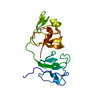[English] 日本語
 Yorodumi
Yorodumi- PDB-2m3t: Solution-state NMR structure of wild-type human gamma(S)-crystallin -
+ Open data
Open data
- Basic information
Basic information
| Entry | Database: PDB / ID: 2m3t | ||||||
|---|---|---|---|---|---|---|---|
| Title | Solution-state NMR structure of wild-type human gamma(S)-crystallin | ||||||
 Components Components | Beta-crystallin S | ||||||
 Keywords Keywords |  STRUCTURAL PROTEIN / gamma-S / STRUCTURAL PROTEIN / gamma-S /  eye lens / aggregation / eye lens / aggregation /  crystallin / crystallin /  cataract / CRYGS cataract / CRYGS | ||||||
| Function / homology |  Function and homology information Function and homology informationstructural constituent of eye lens / lens development in camera-type eye /  visual perception / morphogenesis of an epithelium visual perception / morphogenesis of an epitheliumSimilarity search - Function | ||||||
| Biological species |   Homo sapiens (human) Homo sapiens (human) | ||||||
| Method |  SOLUTION NMR / SOLUTION NMR /  simulated annealing simulated annealing | ||||||
| Model details | minimized average structure, model 1 | ||||||
| Model type details | minimized average | ||||||
 Authors Authors | Brubaker, W.D. / Martin, R.W. | ||||||
 Citation Citation |  Journal: Structure / Year: 2013 Journal: Structure / Year: 2013Title: Preferential and Specific Binding of Human alpha B-Crystallin to a Cataract-Related Variant of gamma S-Crystallin. Authors: Kingsley, C.N. / Brubaker, W.D. / Markovic, S. / Diehl, A. / Brindley, A.J. / Oschkinat, H. / Martin, R.W. | ||||||
| History |
|
- Structure visualization
Structure visualization
| Structure viewer | Molecule:  Molmil Molmil Jmol/JSmol Jmol/JSmol |
|---|
- Downloads & links
Downloads & links
- Download
Download
| PDBx/mmCIF format |  2m3t.cif.gz 2m3t.cif.gz | 1.1 MB | Display |  PDBx/mmCIF format PDBx/mmCIF format |
|---|---|---|---|---|
| PDB format |  pdb2m3t.ent.gz pdb2m3t.ent.gz | 978.4 KB | Display |  PDB format PDB format |
| PDBx/mmJSON format |  2m3t.json.gz 2m3t.json.gz | Tree view |  PDBx/mmJSON format PDBx/mmJSON format | |
| Others |  Other downloads Other downloads |
-Validation report
| Arichive directory |  https://data.pdbj.org/pub/pdb/validation_reports/m3/2m3t https://data.pdbj.org/pub/pdb/validation_reports/m3/2m3t ftp://data.pdbj.org/pub/pdb/validation_reports/m3/2m3t ftp://data.pdbj.org/pub/pdb/validation_reports/m3/2m3t | HTTPS FTP |
|---|
-Related structure data
- Links
Links
- Assembly
Assembly
| Deposited unit | 
| |||||||||
|---|---|---|---|---|---|---|---|---|---|---|
| 1 |
| |||||||||
| NMR ensembles |
|
- Components
Components
| #1: Protein | Mass: 20959.633 Da / Num. of mol.: 1 Source method: isolated from a genetically manipulated source Source: (gene. exp.)   Homo sapiens (human) / Gene: CRYGS, GRYG8 / Variant: Wild-Type / Production host: Homo sapiens (human) / Gene: CRYGS, GRYG8 / Variant: Wild-Type / Production host:   Escherichia coli (E. coli) / Strain (production host): Rosetta (DE3) / References: UniProt: P22914 Escherichia coli (E. coli) / Strain (production host): Rosetta (DE3) / References: UniProt: P22914 |
|---|
-Experimental details
-Experiment
| Experiment | Method:  SOLUTION NMR SOLUTION NMR | ||||||||||||||||||||||||||||||||||||||||||||||||||||
|---|---|---|---|---|---|---|---|---|---|---|---|---|---|---|---|---|---|---|---|---|---|---|---|---|---|---|---|---|---|---|---|---|---|---|---|---|---|---|---|---|---|---|---|---|---|---|---|---|---|---|---|---|---|
| NMR experiment |
|
- Sample preparation
Sample preparation
| Details |
| ||||||||||||||||||||||||||||||||||||||||||||
|---|---|---|---|---|---|---|---|---|---|---|---|---|---|---|---|---|---|---|---|---|---|---|---|---|---|---|---|---|---|---|---|---|---|---|---|---|---|---|---|---|---|---|---|---|---|
| Sample |
| ||||||||||||||||||||||||||||||||||||||||||||
| Sample conditions |
|
-NMR measurement
| NMR spectrometer | Type: Varian INOVA / Manufacturer: Varian / Model : INOVA / Field strength: 800 MHz : INOVA / Field strength: 800 MHz |
|---|
- Processing
Processing
| NMR software |
| ||||||||||||||||||||||||||||||||||||
|---|---|---|---|---|---|---|---|---|---|---|---|---|---|---|---|---|---|---|---|---|---|---|---|---|---|---|---|---|---|---|---|---|---|---|---|---|---|
| Refinement | Method:  simulated annealing / Software ordinal: 1 simulated annealing / Software ordinal: 1 | ||||||||||||||||||||||||||||||||||||
| NMR constraints | NOE constraints total: 7444 / NOE intraresidue total count: 1547 / NOE long range total count: 3052 / NOE medium range total count: 1286 / NOE sequential total count: 1559 | ||||||||||||||||||||||||||||||||||||
| NMR representative | Selection criteria: minimized average structure | ||||||||||||||||||||||||||||||||||||
| NMR ensemble | Conformer selection criteria: structures with the lowest energy Conformers calculated total number: 200 / Conformers submitted total number: 21 |
 Movie
Movie Controller
Controller













 PDBj
PDBj
